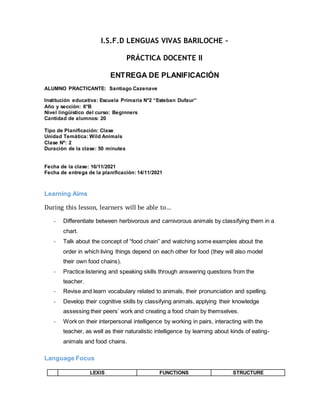
Classifying Animals and Modeling Food Chains
- 1. I.S.F.D LENGUAS VIVAS BARILOCHE – PRÁCTICA DOCENTE II ENTREGA DE PLANIFICACIÓN ALUMNO PRACTICANTE: Santiago Cazenave Institución educativa: Escuela Primaria N°2 “Esteban Dufaur” Año y sección: 6°B Nivel lingüístico del curso: Beginners Cantidad de alumnos: 20 Tipo de Planificación: Clase Unidad Temática: Wild Animals Clase Nº: 2 Duración de la clase: 50 minutes Fecha de la clase: 16/11/2021 Fecha de entrega de la planificación: 14/11/2021 Learning Aims During this lesson, learners will be able to… - Differentiate between herbivorous and carnivorous animals by classifying them in a chart. - Talk about the concept of “food chain” and watching some examples about the order in which living things depend on each other for food (they will also model their own food chains). - Practice listening and speaking skills through answering questions from the teacher. - Revise and learn vocabulary related to animals, their pronunciation and spelling. - Develop their cognitive skills by classifying animals, applying their knowledge assessing their peers’ work and creating a food chain by themselves. - Work on their interpersonal intelligence by working in pairs, interacting with the teacher, as well as their naturalistic intelligence by learning about kinds of eating- animals and food chains. Language Focus LEXIS FUNCTIONS STRUCTURE
- 2. R E V Vocabulary related to wild animals, habitats and food. Answering WHand yes/no questions Present Simple N E W New vocabulary related to wild animals, food and concepts like “food chain, herbivores, carnivores, omnivores”. Materials _The video of animals eating. _National Geographic and animal magazines. _Herbivores/carnivores chart. _Marker pen _Exit tickets Procedures (up to 3 minutes) I will greet students and ask them what date is today. I will start the lesson by asking students the following question: “what do animals need in order to survive?” I expect them to answer that they need a nice place to live and food among other things. I will organize their suggestions on the board. This question serves as a pre-watching task. Transition: “That’s right! Actually, they need the same things we need as humans.” (12 minutes) Now I will tell students to watch a short video about animals and pay attention to kinds of food that appear in it, I will ask them a couple of questions to discuss with the whole class to revise vocabulary related to animals, habitats and food. Link to the video: https://www.youtube.com/watch?v=kXNK6ezUkmc - “What animals did you see?” - We can also re-watch some parts of the video and ask: “What is the name of this animal?” in case they didn’t mention all of them (An elephant, bulls, a tiger, monkeys, camels, kangaroos, a giraffe, turtles, a bear, seal, lemur). - “Are they in their natural habitats? Where are they?” - “What are they doing? Is everybody eating the same food? What are they eating?”
- 3. I will teach some vocabulary related to food that appears in the video: “Pumpkin, plants, fruits, etc.”. Then I will say something like “As you know, there are three different types of food-eating animals. Can anyone name the three types of food-eating animals?” (I will elicit their answers) I expect them to say: “carnivores (meat eaters), herbivores (plant eaters) and omnivores (those that eat both)” Transition: “Alright! Let's focus on carnivorous and herbivorous animals for now” Activity 1: (10 minutes) For this activity students will work in pairs. I will distribute some National Geographic magazines and other similar around the class. Students should find and cut pictures from carnivorous and herbivorous animals (one of each) and place them in the category they belong in a chart the I’m going to stick to the board. Chart: Carnivores Herbivores Pictures of: cat, sharks, snakes, etc. Pictures of: camels, elephants, monkeys, etc. Once they all finish, we will discuss and check their choices together. I will ask: “Is this animal a carnivore/herbivore? What does the lion/zebra/dog eat? Do animals eat other animals?” Transition: “Very good answers! That's how a food chain is formed” Activity 2: (15 minutes) Students will choose one of the animals from the chart and draw their food chain using arrows from these animals to smaller carnivores/herbivores and arrows to larger carnivores. Before the activity, I will briefly explain what a food chain is and illustrate what it looks like on the board. Students will help me with my drawing and the food chain. Example: Scaffolding strategies: I will go around the classroom and check students work, helping them in case they don’t know/remember key vocabulary or if they don’t know the food
- 4. chain of their animal. I will try not to use L1, but only gestures, miming, giving clues, asking questions or even asking other students for help. Transition: “Your food chains are amazing, but before we finish... one last game” Students will complete an “Exit Ticket”. The exit ticket will require them to connect four animal names in a messy food chain only using arrows in the correct direction (from the last link to the first). Once they all hand in their tickets, the class will be over. I will demonstrate how to do it first with a card. Sample ticket: Exit Ticket: Bird – Owl – Caterpillar – Snake Transition: “Good job everybody! See you on Thursday”